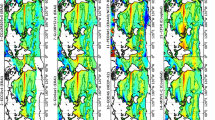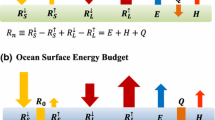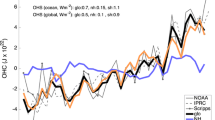Abstract
Comprehensive diagnostic comparisons and evaluations have been carried out with the National Centers for Environmental Prediction/National Center for Atmospheric Research (NCEP/NCAR) and European Centre for Medium Range Weather Forecasts (ECMWF) reanalyses of the vertically integrated atmospheric energy budgets. For 1979 to 1993 the focus is on the monthly means of the divergence of the atmospheric energy transports. For February 1985 to April 1989, when there are reliable top-of-the-atmosphere (TOA) radiation data from the Earth Radiation Budget Experiment (ERBE), the implied monthly mean surface fluxes are derived and compared with those from the assimilating models and from the Comprehensive Ocean Atmosphere Data Set (COADS), both locally and zonally integrated, to deduce the implied ocean meridional heat transports.
While broadscale aspects and some details of both the divergence of atmospheric energy and the surface flux climatological means are reproducible, especially in the zonal means, differences are also readily apparent. Systematic differences are typically ∼20 W m−2. The evaluation highlights the poor results over land. Land imbalances indicate local errors in the divergence of the atmospheric energy transports for monthly means on scales of 500 km (T31) of 30 W m−2 in both reanalyses and ∼50 W m−2 in areas of high topography and over Antarctica for NCEP/NCAR. Over the oceans in the extratropics, the monthly mean anomaly time series of the vertically integrated total energy divergence from the two reanalyses correspond reasonably well, with correlations exceeding 0.7. A common monthly mean climate signal of about 40 W m−2 is inferred along with local errors of 25 to 30 W m−2 in most extratropical regions. Except for large scales, there is no useful common signal in the tropics, and reproducibility is especially poor in regions of active convection and where stratocumulus prevails. Although time series of monthly anomalies of surface bulk fluxes from the two models and COADS agree very well over the northern extratropical oceans, the total fields all contain large systematic biases which make them unsuitable for determining ocean heat transports. TOA biases in absorbed shortwave, outgoing longwave and net radiation from both reanalysis models are substantial (>20 W m−2 in the tropics) and indicate that clouds are a primary source of problems in the model fluxes, both at the surface and the TOA. Time series of monthly COADS surface fluxes are shown to be unreliable south of about 20∘N where there are fewer than 25 observations per 5∘ square per month. Only the derived surface fluxes give reasonable implied meridional ocean heat transports.
Similar content being viewed by others
Author information
Authors and Affiliations
Additional information
Received: 21 March 2000 / Accepted: 21 June 2000
Rights and permissions
About this article
Cite this article
Trenberth, K., Caron, J. & Stepaniak, D. The atmospheric energy budget and implications for surface fluxes and ocean heat transports. Climate Dynamics 17, 259–276 (2001). https://doi.org/10.1007/PL00007927
Issue Date:
DOI: https://doi.org/10.1007/PL00007927




